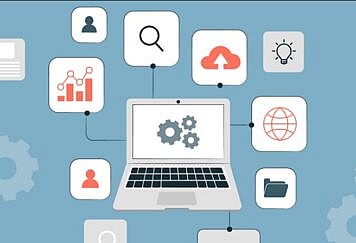If there’s one area where the current Covid-19 pandemic has changed the world, it’s in learning and education. Surveys show that with schools shut across 186 countries, nearly 1.2 billion children have been compelled to stay home. This abrupt shift away from face-to-face teaching and learning has been received with mixed emotions. For some, it’s an amazing opportunity to leverage technology in the field of pedagogy, while for others, it’s a stop-gap solution till schools finally revert to the conventional format.
This impact has been felt even more in the corporate and employment sectors. Apart from traditional learning, interactive training used to upskill, reskill, and refresh employees is scaling new heights. The mantra today is Be Interactive Or Perish! No employee wants to watch PowerPoint slide shows or attend day-long seminars passively.
Where It All Began
Remember the correspondence or distance learning courses that were so popular a few years ago? They focused on providing specific courses to people who didn’t have the time, money, or inclination to attend a full-scale, full-time academic program.
In the mid-19th century, Isaac Pitman offered his famous shorthand courses via correspondence to pupils who couldn’t attend regular classes. Learners included working journalists, secretaries, and others who needed speedy note-taking skills. Lessons, tests, and answers were exchanged via postal mail.
In the early 20th century, the testing machine was invented by Ohio State University, Professor Sidney Pressey. It provided a rudimentary, automated testing process to give scores at the end of the test.
Post World War 2, with the rising popularity of television and a serious shortage of teaching staff, there was a need for more automated systems. Behavioral psychologist BF Skinner invented the “teaching machine” in 1954, which allowed pupils to receive smaller chunks of information in what was known as Programmed Instruction.
By the 1970s, when IBM rolled out the first personal computers, many teachers with technical skills began to offer their own courses.
In 1999, a new term was invented, “e-learning.” It referred to technology-based learning methods, with access to online, interactive learning. Personalized courses that fulfilled specific needs soon followed.
Today, most on-campus and e-learning courses have some interactive components. Let’s figure out what that means.
What Is Interactive Learning?
This learning method combines and incorporates social networking (where people who share certain goals, backgrounds, interests, and activities come together on a common digital platform) and urban computing (where computer technology is applied in urban settings). These two factors are the cornerstones of course design and delivery.
Virtual communication and digital technology have contributed enormously to the popularity and perfecting of this format. Since 2000, “digital natives” have expected interactive programs to be integral to any course they choose.
Access, storage, and sharing of information have become more convenient, swift, and real-time. With this paradigm shift, teachers have transformed themselves into facilitators rather than storehouses of knowledge, and the lines between learner and facilitator have become increasingly blurred.
In earlier times, one of the perceived disadvantages of distance learning was a lack of face-to-face contact. Technology has solved this issue, and today, no restriction can be placed by time or geography. Static online courses where knowledge flowed only one way are now obsolete.
Typically, formats used in interactive learning include:
- augmented and virtual reality
- interactive presentations
- video conferencing
- webinars and online discussion forums
- virtual classrooms
- screen sharing software
- bulletin boards
- workplace gamification
- intuitive features, and more.
Benefits and Drawbacks
Interactive learning formats foster greater creativity in learners. Much of their material mirrors real-life experiences that learners could encounter in their jobs. Creativity blooms in such situations, where out-of-the-box thinking can emerge safely without actual risks.
Learning gets reinforcement through relevant and timely feedback.
There are greater motivation and retention rates when the interaction flows both ways.
However, the modules and the faculty must be tech-savvy enough to allow the smooth flow of information. Bandwidth can be a problem if connectivity is not adequate.
Interactive formats are not suitable for some types of learning, such as soft-skills development that requires face-to-face contact. It may not appeal to certain categories of learners who are not self-motivated or self-disciplined.
How To Incorporate Interactive Training?
While the elements of knowledge sharing remain at the heart of all interactive training programs, keep these points in mind while creating your interactive training modules:
- Visual Appeal: Most of your learners are probably millennials who are very comfortable with online content. Keeping them involved with graphics-rich videos with short bursts of relevant content, highlighting the main points, will ensure recall. Include features such as click-n-reveal, drag-n-drop, voice-overs, animation, interactive slides, and more. 360-degree videos and images, virtual tours, immersive learning experiences, and VR can benefit your sessions.
- Digital Storytelling:this technique makes the learner the story’s protagonist, controlling content and flow. This is great for onboarding, setting role expectations, and making your organization more human/humane. You can also include simulated scenarios that allow learners to virtually reality-test situations that might otherwise be risky in real terms. Branching scenarios help learners take control and boost engagement, while facilitators can provide feedback to align learning and evaluate decision-making and critical thinking.
- Gamification:Applying game-design features, principles, and elements in non-game situations such as interactive learning programs leverage the power of typical elements such as leaderboards, badges, and points to facilitate learning. Computer games, apps, classroom games, and e-learning platforms can successfully be transformed into effective interactive learning situations.
- Regular Evaluation: Interactive learning provides opportunities for regular and rigorous testing and evaluation. Quizzes, assessments, and tests can give learners and facilitators a better perspective on the learning curve and gauge the program’s effectiveness. It helps in recall and reinforces what has already been absorbed.
- Keep it Brief:Interactive learning sessions are typically short, sharp bursts with high energy, absorption, and exchanges. Incorporate plenty of micro-learning elements in every interactive training session. This helps learners on the go to complete their sessions during a commute or a lunch break. Today’s desk-less offices and work trends are ideally suited to interactive learning with shorter training sessions. It benefits shorter attention spans and helps the learner retain focus for the duration.
Creating an interesting, effective, relevant, and useful interactive training program requires a superb blend of hardware, software, knowledge of the subject, experience, and creativity. This is a new reality, and unless you incorporate these elements into your training sessions, you could find yourself and your company lagging in the knowledge race.
Follow TechStrange for more Technology, Business and Digital Marketing News.





